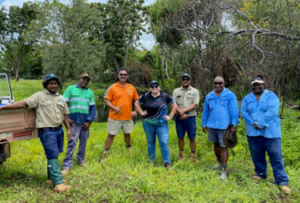This update represents just a handful of NRM projects among hundreds across Australia, which are made possible through funding from the Australian Government, state governments and others.

Rabbit rats birthed on new island home – Territory NRM, Northern Territory
In August 2023 Territory NRM successfully translocated 46 brush-tailed rabbit-rats (Conilurus penicillatus) to a remote island within Garig Gunak Barlu National Park. Since then, at least three of the threatened rodents have produced babies, offering new hope for the species.
The endangered semi-arboreal rodent appears to be almost extinct from all but the Cobourg Peninsula and a few remote islands. As with many small mammals in Australia, rabbit-rats are threatened by hot fires, habitat loss, predation by feral cats, and competition from introduced species.
Monitoring of the rabbit rat population will be ongoing with data being collected from each individual’s radiotransmitting collar and a grid of camera traps.
Read the Territory NRM newsletter for more information.

Adelaide’s tree canopy levels below target – Green Adelaide, South Australia
The Urban Heat and Tree Canopy Mapping, led by Green Adelaide, is the first where state and local government have partnered to capture tree canopy data for the entire Adelaide metropolitan area providing a regionally consistent dataset and a full picture of tree canopy levels.
The study showed approximately 17% of metropolitan Adelaide is covered in tree canopy. This represents an increase of nearly 4% compared to similar surveys in 2018 and 2019, but still falls below the widely accepted target of 30% for urban areas.
Read more here and get the report.

Turtles in trouble? – Gulf Savannah NRM, Queensland
Gulf Savannah NRM and Tagalaka Aboriginal Corporation’s Turtles in Trouble project is investigating whether the northern snake-necked turtles (Chelodina rugosa) population is declining at Littleton National Park, located 40 km east of Croydon.
In 2023 the project established a turtle population baseline estimate and upskilled the Tagalaka people in turtle monitoring and threat-mitigation activities on Country. This year, the projects is focused on expanding the monitoring program and exploring innovative fencing solutions to safeguard turtle habitat from feral pig impacts.
Read more here.

Rangers using science to preserve cane toad free zone – Torres Strait Regional Authority, Queensland
Torres Strait Regional Authority (TSRA) rangers are learning to use environmental DNA (eDNA) sampling to detect cane toads. It’s hoped that early identification of a cane toad presence can help to eradicate any new infestations and restrict the toads from colonising the outer islands of the Torres Strait- one of the only areas of Queensland that remains cane toad free.
Senior TSRA Mura Badhulgau Ranger Laurie Nona said cane toads posed threats to natural and cultural heritage, including the Karabi (Great Egret), whose feathers are used for making traditional headdress known as Dhari. “Karbai (Great Egret) provide the most pure white feathers for making Dhoeri,” Mr Nona said. “If cane toads established on Badu, we could lose the Karbai, forever severing ties to our ancestors’ traditional ways of making the Dhoeri using Karbai feathers.”
Read more here.

Collaborative efforts restore the Cann River – East Gippsland Catchment Management Authority (CMA), Victoria
The East Gippsland CMA have joined forces with the Moogji Aboriginal Council and the Cann River Landcare Group to enhance sections of the Cann River’s ecosystems and improve the health of the floodplain with ongoing weed control, revegetation, erosion control and condition monitoring along the river.
East Gippsland CMA CEO, Bec Hemming, emphasised the importance of the partnerships, “Partnerships with Aboriginal groups, landholders and community play a vital role in improving waterway health into the future” she said.
Read the project update and overview.

Pasture monitoring in the Rangelands – Western Local Land Services (Western LLS), New South Wales
The Producer Demonstration Site (PDS): Pasture Monitoring in the Rangelands project commenced in 2022 with four producer sites established in the Oxley and Booligal region, building off the Improving Tactical Decision Making pilot program which assisted landholders with the adoption of strategic grazing management practices to improve farm business profitability.
The PDS project tracks key native and naturalised rangeland pasture species at two stages throughout the year, aligned with growth phases, delivering critical pasture monitoring and plant identification skills to land managers.
Read more here.

Felixer Traps being trialled to curb cat migration – NRM South, Tasmania
Since 2018, NRM South has been working with project partners targeting control of feral and stray cats on north Bruny Island. The project focus is protection of Eastern Quolls, with flow-on benefits for all native birds and mammals like the Dusky Antechinus, Short-tailed Shearwaters and Little Penguins.
In 2023, this project received a year-long extension to assess ongoing management interventions. A review by Biosecurity Tasmania concluded that the use of the Felixer traps, in combination with other control techniques, could provide a valuable and complementary tool to managing a northern migration of feral cats from the island’s south.
Read more here.

Start of another fire season on the Dampier Peninsula - Rangelands NRM, Western Australia
Facilitated by Rangelands NRM, each year the members of the Dampier Peninsula Fire Working Group come together in late March to discuss their burn plans for the coming season.
The group, established in 2016 in response to sequential years of extreme fire seasons (see video), is led by Indigenous Ranger groups made up of Bardi Jawi, Nyul Nyul, Yawuru, and other fire managers from a range of stakeholders; Kimberley Land Council, station owners, relevant government departments, WWF and the Shire of Broome.
Read the Facebook updates: https://www.facebook.com/share/p/wYvowZb7o9TBzrgr/?
https://www.facebook.com/share/p/bKozf1nySu39H5Ts/?
Watch the Video: Managing Wildfire with the Dampier Peninsula Fire Working Group (youtube.com)
